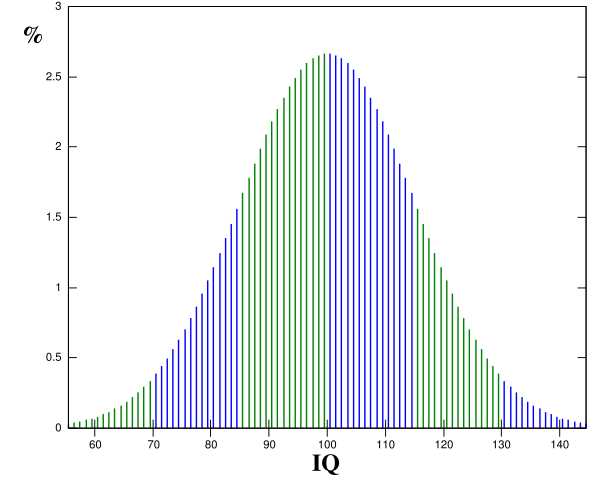
IQ (intelligence quotient) according to Sternberg (1996) deals with inert intelligence, not leading to goal-directed movement or action.
According to Schenk (2007), IQ only shows current academic achievement.
Most people are around an IQ of 100 (see the graph to the left), 50% between 90 and 110, 2.5% score over 130 or under 70.
Because of the ceilings in tests, it takes more effort and additional testing to get clear in which areas highly gifted are excelling (Silverman, 1995).
“I.Q. does not identify most “talents” or special abilities — and absolutely does not enable us to predict who will grow up to become extraordinary scientists, musicians, teachers, leaders, or athletes. It predicts general success, but not greatness.” Schenk, 2007.
What IQ doesn’t Tell
According to Sternberg (1996) IQ doesn’t tell about successful intelligence i.e., if a person is capable of achieving his or her goals.
Neither does IQ give information about creativity (Taylor, 1975), one of the most necessary parts in solving problems.
“If the aborigine drafted an IQ test, all of Western civilisation would presumably flunk it.” Stanley Garn (1922 – 2007, professor of physical anthropology)
Practical intelligence is not measured (Miller, 1997) and, according to Howard Gardner (2005), neither is emotional intelligence or personal growth potential.
To be able to put intelligence to use one needs practical intelligence to have the practical skills needed to achieve one’s goals, and emotional intelligence in being able to communicate effectively, an essential capability to attain one’s aim.
Personal development and learning should be aimed at more than the development of IQ or analytical intelligence alone. It should also focus on acquiring lifelong learning skills on all the different qualities and skills needed (e.g. creativity, practical and emotional intelligence) in order to be able to explore one’s own potential.
Emotion Regulation
Multilevel Emotion Regulation Theory (MERT) is a holistic theory developed by Simone de Hoogh. The theory explains how neurodiverse (young) individuals and parents of neurodiverse children can develop emotional regulation skills and direct their energy towards self-chosen goals, and contribute to society.
PowerWood’s Community
Find understanding, tools and strategies that work in an understanding, respectful and compassionate Community.
PowerWood can be your and your families advocate and your second family.
Explore how joining our PowerWood community by becoming a member will benefit you and your family and what types of memberships are available.
Join our Community
Available to Members*
*Booking a one-off Free Introductory Talk of 45-60 minutes by Skype or FaceTime with Senior Consultant Simone de Hoogh is one of the benefits of being either a FreeBee PowerWood Community Member or a Friend PowerWood Community Member.
Book a FREE Introductory Talk with a Professional*
You can read more about PowerWood’s Consultancy Sessions, the Benefits of a Free Introductory Talk and PowerWood’s Consultancy Services Tiered Fee Structure.
*Overexcitability Test
OE (Overexcitability) is an element of a Developmental Theory –Theory of Positive Disintegration by Dabrowski- that is one of the underpinning theories of MERT (Multi-level Emotion Regulation Theory) developed by Simone de Hoogh. Overexcitability explains and allows us to look at ‘extreme’ behaviour as a valuable asset in our or our children’s life.
Find out if you or your child has OE (OverExcitability) as well
*Boundary Test
A HUGE thank YOU to the son and daughter of Ernest Hartmann’s who gave PowerWood permission to use and put the full academically approved questionnaire about the Boundary in the Mind on PowerWood’s website.
Find out how the Boundary in the Mind affects you or your child
